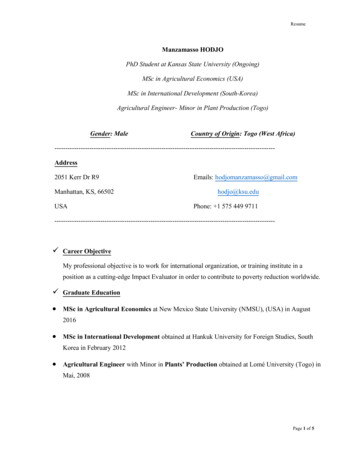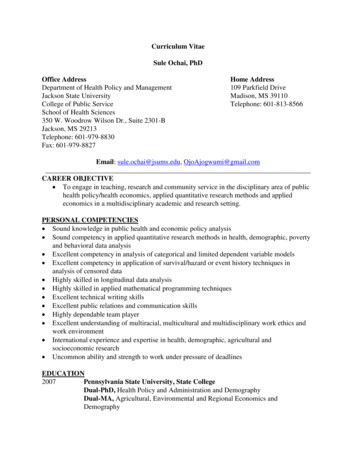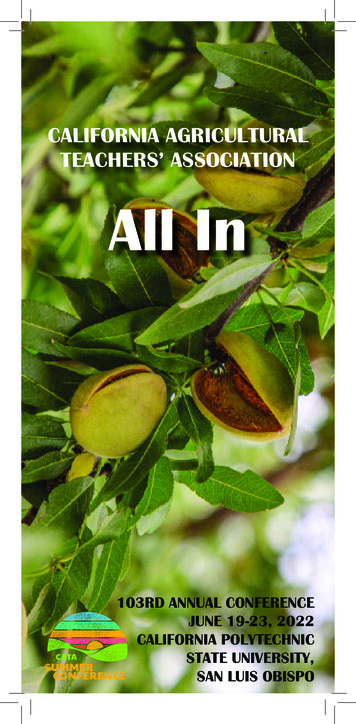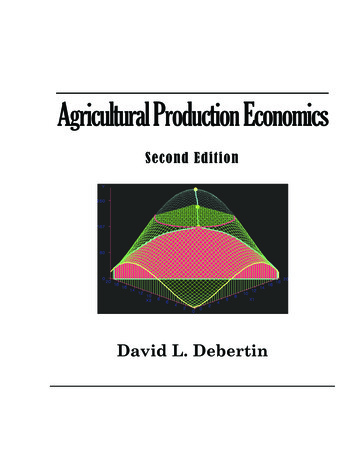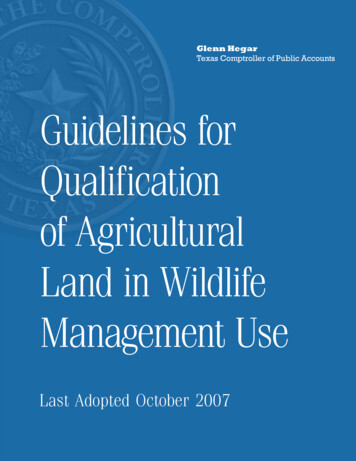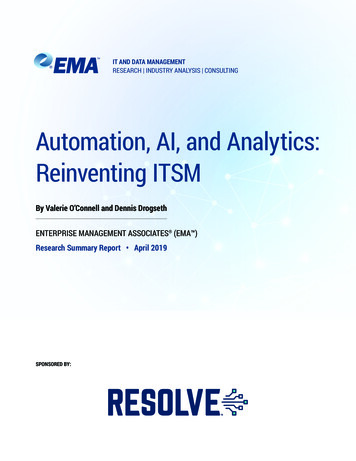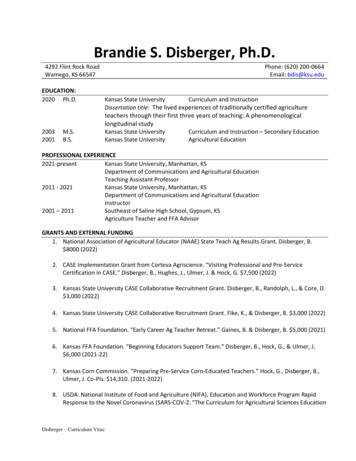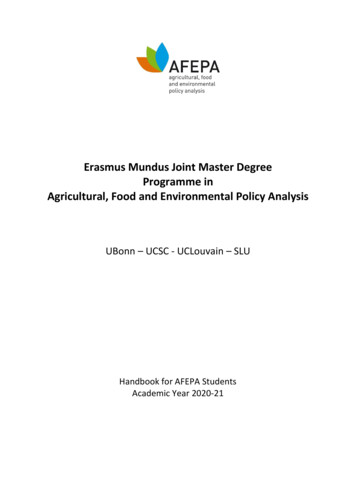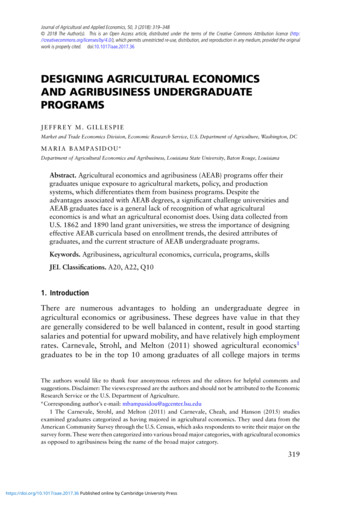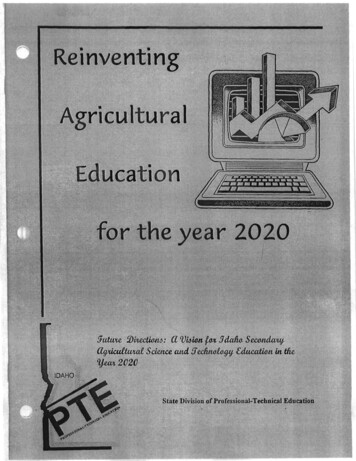
Transcription
einventingAgriculturalEducationey r 2020fJutuu, 9)iudioIt6: a Vi6iM f.o4 3dJuJ. SwuuUvuj.lbpdadtwud Seknu and 5 UluadUm in tfte'ljeM2020State Division of Professional-Technical Education
VE344Reinventing AgriculturalEducation for the year 2020Future Directions: A Vision for Idaho SecondaryAgricultural Science and Technology Education in the Year 2020JULy,1999A Strategic Report t project***conducted by:The University of Idaho Department ofAgricultural and Extension EducationThe Idaho State Division of Vocational EducationThe Idaho Vocational Agriculture TeachersAssociationAs part of a nationwide program sponsored by the W. K. Kellogg Foundationand administered by the National Council for Agricultural Education.1
TABLE OF CONTENTSPAGE NO.1INTRODUCTIONPREFACE3PRESENT SITUATION6SECONDARY AGRICULTURAL EDUCATION8FUTURE DIRECTION10PROCESS FOR LEARNlNG,18MINIMUM PROGRAM STANDARDS19PROGRAM CURRICULUM AND CONTENT22AGRICULTURAL SCIENCE AND TECHNOLOGY24SUGGESTED MODELS FOR SCOPE AND SEQUENCE26SUGGESTED DELIVERY SCHEDULE27MIDDLE/JUNIOR HIGH AGRICULTURAL EDUCATION29FUNDING OF APPROVED PROGRAMS31SUPERVISED AG. EXPERIENCE/SUMMER PROGRAMS33NATIONAL FFA ORGANIZATION35INSTRUCTOR RECRUITMENT36lMAGEAND COMMUNICATION37GUIDELINES FORSECONDARY AG. ED.PROGRAMS.2.38
PREFACEJt is generally safe to say that at no timeagricultural educators here in Idaho havedone much to address the many changeswhich have occurred and are continuingtoday. Through the efforts of many, we haveaddressed issues: affecting high schoolgraduation and college entrancerequirements, science credit for agriculturecourses, the development of a secondaryagriculture curriculum outline andcurriculum resources guides, programphilosophy, and a tactical plan foragricultural education in Idaho.in recent history has education faced and hadto deal with such rapid change. The changesin our world are global and affect worldpolitics, international economics/trade, worldhealth issues, (e.g. AIDS) environmentalissues, and the world supply of safe andnutritious food. These changes and othersaffect the educational system in our nationand in our local communities.We as a nation and state have pressingissues which must be addressed at least inpart by our public schools. These issuesinclude: poverty, illiteracy, violence, drugs,AIDS, single parent homes, homelesschildren, child care and preparing our youngpeople to understand and participate in ademocratic form of self-governance. Schoolsnow fuce the task of addressingcontemporary social issues as well asteaching traditional subjects.With all of this the fuet remains, confusionexists as to what we believe constitutes a"program" of agricultural education in anIdaho high school Some confusion isunderstandable given we have changed to:numbered semester courses, science creditcourses, and business management countingfor consumer economics. The structure ofan Idaho school day varies greatly andincludes: six-period days, seven-period days,eight-period days, eight-period roll over andtri-semester schedules. Confusion isunderstandable given the changes in coursecontent and reporting, along with scienceand economics credit given for some classesand a wide variety of school day structures.In all of this, we must maintain programintegrity and not compromise the basic5he continuing questions for secondaryagricultural education are then: Do we fit,and how do we fit in today's educationaldelivery system? In our mind there is noquestion that we do indeed fit. The largerquestion and not so easily answered is, howdo we fit? In order to effectively resolvethese questions, it will require exemplaryand visionary leadership from all ofus. Wemust charge ourselves with the resolve tochart our own future as we look forward tothe year 2020 and all ofthe challenges it willbring.components of our program: classroomand laboratory instruction, the FFAorganization and supervised agriculturalexperience (SAE).3
agricultural educators in Idaho have beenchallenged as we have deah with theseissues. We believe that it is safe to say thatmost teachers have struggled withstructuring a local program which meetscommunity needs, and in the larger sense, fitsinto the total framework ofthe educationaldelivery system at the local, state, nationaland global levels. The Department ofAgricultural and Extension Education ischarged with the preparation ofteachers foragriculture programs both in the present andfuture. The department needs the dialogue,interaction, and consensus ofthe professionas it works with the future teachers and plansand delivers their professional course work.The State Division ofVocational Educationwill continue to utilize the consensus of allstakeholders as it provides overall leadership,guidance and direction dealing withapproving and supporting programs.5he 1992 project committee included:Jon Fabricius - GeneseeKeith Hyatt - PayetteSteve Wilder - MeridianJoe Blackstock - KunaAlan Schoen - RimrockTom Woodland - GoodingRon Thaemert - BuhlMarc Beitia - American FaIlsKent Scott - MaladMark Pratt - FirthAlan Heikkila - HighlandDave Ross - TetonDon Bird - West JeffersonCraig Clapier - NampaStuart Nesbitt - WeiserDeVere Burton - BoiseRichard Ledington - PocatelloLou Riesenberg - MoscowJohn Mundt - Boise5his work is based in part on the 1992report, Future Directions: IdahoIn 1996, a three year national initiativeReinventing Agricultural Education forthe Year 2020 was organized. ThisSecondary Agricultural Science andTechnology Education, which was ainitiative was sponsored by the W.K. KelloggFoundation as a special project oftheNational FFA Foundation and wascoordinated by the National Council forAgricultural Education (THE COUNCIL).Idaho was involved in this coordinatednational effort as a member of an eleven stateconsortium and Idaho's project is part ofthenational strategic plan for agriculturaleducation well into the next century.landmark work in planning for contemporaryagricultural education by a select group ofIdaho educators. Much ofthe 1992 reportwas retained and revised for this project.4
an Idaho task force committee of 44 menand women met in October, 1997 in TwinFalls representing business and industry,education, legislative, agriculture andagricultural education professionals. Thiscommittee's mission was to identify apreferred future for Idaho agriculturaleducation (vision), focus on a strategicmission and to identify a planning frameworkand priorities. The committee was chargedwith taking an internal look at AgriculturalScience and Technology programs in Idahoand established the foundation for thiscurrent report.5he report which follows is a compositeoftheir individual and collective effort. It isintended that this report be utilized by: policymakers, administrators, agriculturaleducators, parents, members of advisorycommittees, and the industry of agriculture.5his ''2020'' project is comprised of a threepart continuous process:Part IEstablish a preferred futurefor agricuhural educationPart II Develop a strategic planPart III Methods are exploredand enacteda select writing committee was assembledin May, 1998 to orchestrate the Idaho 2020plan as you see it represented here withseveral ofthe individuals having beeninvolved with the 1992 project. Thecommittee was endorsed and supported bythe Idaho Vocational Agricultural TeachersAssociation (IVATA), the State Division ofVocational Education (SDVE) and theDepartment of Agricultural and ExtensionEducation at the University ofIdaho. There1998 committee members were:Larry Judd - LapwaiJim Sunnners - WestsideAlan Heikkila - HighlandSteve Hines - CastlefordBill Dean - EmmettTom Woodland - GoodingAlan Schoen - RimrockGary Abercrombie - AberdeenDoug Pals - MoscowJohn Mundt - BoiseDean Langley - Boise5
THE PRESENT SITUATIONSecondary Agricultural Scienceand Technology Program:Definedmanagement, mechanics, and engineering.The allied industries of agricuhure are themajor employers in the state.Secondary Schoolsa Secondary Agricultural Science andTechnology program in Idaho is definedas an organized sequential program ofinstruction for secondary students thataddresses agricultural services and manyphases of production, processing, anddistribution of agricultural products. Theprogram includes basic principles ofscience, communications and math thatare inherent to the curriculum andpromote the concept of environmentalawareness. Student leadership activitiesand supervised agricultural experienceprograms are considered to be integralparts of the program ofinstruction.Appropriate program outcomes includeentry level employment in the agriculturalindustry or enrollment in post-secondaryluniversity degree programs.agricuhmal education programs arelocated in 89 ofthe public secondary schoolsin Idaho. These schools with agriculturaleducation programs are classified by size asfollows:Secondary Schools with AgriculturalProgramsClass of schoolofprogramsA-IA-2A-3A-4Number18202027!L uring the 1985-86 school year therewere approximately 3900 agricuhuraleducation students enrolled in and served bythe 75 secondary schools that offeredagricultural education programs at that time.A new curriculum was implemented in Idahoduring the 1989-90 school year. The numberof students enrolled in the program hasincreased each year since that time. Some ofthe increase is thought to be due to changesin the scheduling format in some schools.The cumulative effects ofthe two changes isevident in larger enrollments in programsacross the state. The total enrollment inAgricultural Science and Technology in1997-98 was 8,971 students enrolled in 89programs. Other trends that are evident forthe same period oftime are decreases in thepercentage of students who participate inSAE (supervised agricuhural experience)programsand who are members .ofthe FFA.Idaho, An Agricultural StateB'he basic and most prominent industry inIdaho is agricuhure. Agriculture and alliedindustries supply nearly half of Idaho s grossproduct and employ more than one-third ofIdaho s labor force; while nationally,agricuhure accounts for one in five jobs.Over 20 percent ofthe gross nationalproduct can be tied to the agriculturalindustry.J daho produces approximately 95agricultural commodities which makes it avery diversified agricuhural state. Thisintense and diverse production agriculturalindustry is supported by an equally diverseallied agnbusiness industry; ranging fromagricuhural sales and service, processing anddistnbution to agricuhurai marketing,6
Secondary Agricultural Science andTechnology Programs9'he 89 secondary programs in Idaho areinstructed by l08 Agricuhural Science andTechnology teachers. The programs arediverse in nature with the instructionalemphasis focusing on community needs. Sixschools specialize their curriculum towardnatural resources, fish and wildlifemanagement. The youth organization (FFA)and Supervised Agricuhural ExperiencePrograms (SAEP's) are integral componentsin most secondary programs. Thebackgrounds of students enrolled in theprograms are broad and varied. Themajority ofthe students enrolled do not liveon commercial furms. They reside on smallacreages or within the residential areas.Increasingly, younger students (seventh andeighth grades) are enrolling in IdahoprogramsAgricultural EnrollmentIFFAMembership 1986-98FFA% FFAYear Enrollment Membership .119988971370041.2approximately forty·five (45) percent ofthe students participate in an SAE program.In recent years there has been an increase inthe number of SAE placement and workexperience programs.:Justover forty (40) percent ofAgricuhural Science and Technologystudents are members ofthe FFA andparticipate in a variety ofactivities offered bythe youth organization at local, district, state,and national levels. Many more studentsbenefit from FFA-related curriculum taughtin the classroom.7
SECONDARY AGRICULTURAL EDUCATIONProgram Vision, Mission and PbilosophyA.3t is expected that students enrolled inAgricultural Science and Technologywill have an approved SupervisedAgriculture Experience Program(SAEP). SAEP's in realistic settingsprovide students the opportunity to putinto practice those skills andcompetencies acquired in the traditionalschool setting. All students with the helpof their instructor and their parents shallselect an appropriate program related tothe student's resources and interests. Allstudents will be expected to keep neatand accurate records of their program.The instructor shall provide on-siteinstruction and supervision periodicallythroughout the year.VisionFor the 21st century, agriculturaleduC3tion will be a vital part of everyperson's education and will be viewedas an asset to the community.B.MissionThe mission ofAgricultural EduC3tionis to prepare and support individualsfor careers, build awareness anddevelop leadership for the food, fiberand natural resource system.C.Philosophyall students enrolled are encouraged toSecondary Agricultural Science andTechnology Education is acommunity-based, multi-year program.It is a sequential, semester-basedprogram which prepares students withcompetencies in the spec areas ofagricultural occupations. The programof instruction emphasizes appliedacademics with a hands-on practicalinstructional approach.become members of the local, state, andnational FFA organization. FFA is anintegral component of instruction insecondary agricultural education.Agricultural Science andTechnologylFFA includes instruction inleadership through many avenues suchas: public speaking, parliamentaryprocedure, committee work, andcommunity service activities. FFAcareer development events and otherstudent participation and recognitionactivities are related to the AgriculturalScience and Technology program.9'he curriculum consists of a core andincludes units of instruction which aresystematically sequenced so as to buildon learned competencies. Uponcompletion of the program, a studentshould be able to enter a career in thefood, fiber, or natural resources industry.Many students will elect to further theireducation at the post-secondary level,either at a vocational technical school ora four-year degree granting institution.Secondary Agricultural Education is alearning-by-doing concept. MeaningfulSAE programs and FFA activities allowfor application of classroom andlaboratory knowledge and skills.8
Develop an understanding ofcareer opportunities and thepreparation needed to select,enter, and advance in a food,fiber and natural resourcesoccupation.5he program is a year-round educationalconcept, and extended service for instructors is anecessary requirement in order to meet theobjectives of the program. The local programadvisory committee is involved in local programoperation, future planning and direction.D.ProgramStudentsGoalsThatDevelop career objectives,job-seeking, employability,and job-retention skillsincluding cooperative teammember attitudes.ImpactDevelop competencies andthe basic backgroundknowledge to becomesuccessful in food., fiber andnatural resourcesoccupations. Develop the ability toadvance in an occupationthrough a program ofcontinuing education andlife-long learning.Develop entrepreneurial,business, and managementskills needed by studentspreparing to enteroccupations in the food., fiberand natural resources system. Develop communication skillsand abilities which areessential in any occupation.Develop the abilities neededto exercise and followeffective leadership infulfilling occupational, social,and civic responsibilities.Develop an understanding ofagriculture's relationship tothe environment and ournatural resources.Develop the student's abilityto think critically, solveproblems, and functioneffectively in a competitiveglobal society.9
FUTURE DIRECTIONS: A VISION FOR AGRICULTURALEDUCATION IN THE YEAR 2020I. PartnersGOAL AThe Agricultural EducationProgram will effectivelyutilize partnerships toObjective 3Actively recruit local businessand industry alliances.Strategy1. Utilize Schoolto Work andother career developmentprogramsenhancelocalprogram Objective 1Strategy2. Sponsor businessinternships for agricuhuraleducators.All secondary agricuhuralscience and technologyprograms will have activeAdvisory Committees by theyear 2000.3. Establish a resource list ofpotential collaborativeprojects with business andindustry.1. Recommend the continueduse ofthe present AdvisoryCommittee Handbook(Voc.Ed.#170 & 276) andstress the importance offollowing it's guidelines.4. Utilize business personnelto assist with program eventsto increase awareness andsupport.5. Use industry contacts forequipment acquisition.2. Hold a minimum of twomeetings anhually.Objective 2Capitalize on school andcoIDnl resourcesincluding: administrators,counselors, other teachers,parents, ahmmi and students.Strategy1. Target key individuals forrecognition including:awards, honorary degrees etc.2. Utilize school personneland parents to assist withprogram events to increaseawareness and support.10
Objective 4StrategyII. Image of Agricult:unEstablish strong relationshipswith agriculturalorganizations.1. Sponsor joint activitieswith local/state agencies andorganizations. Such groupscould include: 4-H, Grange,Farm Bureau and Commoditygroups.2. Use post secondaryinstitutions to benefit allagricultural educationprograms.GOAL BObjective 1StrategyLegislators,business/industry leaders,school policy-makers, andgovernment agencies willassist in funding, advising,and providing support forsecondary agricultureprograms.GOAL AAgricultural Education willproject a positive image ofagriculture through publicrelations and marketing.Objective 1Enhance the image ofagriculture education asapplied science, business,management and theintegration of advancedtechnology.Strategy1. Integrate the application ofscience, technology, andapplied academics into thecurriculum.2. Agriculture instructorswork cooperatively withscience and other fucuhymembers within the school.3. Use the Internet, distancetechnology and other sourcesoftechnology to enhanceinstruction.Every agricultural educationprogram will build strongpositive relationships withlocal, state, and federal policymakers.4. Incorporate components ofthe agriculture curriculum toinclude: the global nature ofagricultural production,processing, distribution andmarketing.1. Develop support forindividuals who representagricultural interests.5. Incorporate components ofthe agriculture curriculum toinclude: business managementprinciples and practices,utilization of agriculturalrecord keeping and decisionmaking.11
Objective 2Publish Student SuccessStoriesStrategy1. Incorporate studentsuccess stories into local andstate media to include:newsletters, newspaper,television, and radio.Objective 4Secondary agricuhuraleducation programs willactively promote agricuhureliteracy throughout thecommunity.Strategy1. Local agricuhuraleducation departments shouldwork cooperatively inassisting and promoting thelocal Ag in the Classroomcurriculum.2. Distnoute student successstories to state leaders.3. Publish studentaccomplishments.2. Use FFA members todiscuss agriculture issues atlocal communityorganizations Chamber ofCommerce, Kiwanis, LionsClub, etc.Objective 3Increase the enrollment ofsecondary agricuhuraleducation students and FFAmembership.Strategy1. Have FFA members assistin the recruitment ofnewstudents at the junior high ormiddle schools during theyear.Objective 5At least one Idaho agricuhureeducation instructor will beenrolled in the LeadershipIdaho Agriculture class eachyear.2. Use Agricuhure field daysto fiuniliarize elementary andjunior high students with thelocal FFA program.StrategyNames ofpossible applicantswill be solicited each year atmid-winter planning meetingand submitted to LeadershipIdaho Agricuhure for theapplication process.12
ill. Program FundingGOALOt jective 1Objective 2Within a cooperativejoint venture, the stateof Idaho and localschool districts shaUsupport and fundAgricultural Scienceand TechnologyPrograms to provide upto-date equipment,supplies, resources, andsalaries in such anexemplary manner thatthese programs will bemodels in secondaryeducation of excellenceand achievement inpreparing andsupporting students inpersonal growth, careerawareness andleadership developmentfor the food, fiber andnatural resource system.The state Division ofVocational Education inconjunction with theIdaho legislature shallprovide supplementaryfimding to assist schooldistricts with the addedcosts associated withoperating a qualityAgricultural Science andTechnology Program.Local school districts willcontinue to providenecessary fimding to meetbudgetary needs oftheAgricultural Science andTechnology Program.13Objective 3Local school districts willcontinue to encourageand support AgriculturalScience and TechnologyPrograms to be involvedin loc district, state,regiona and nationalactivities and careerdevelopment events asrelated to programcontent.Objective 4Local school districts willencourage AgriculturalScience and Technologyinstructors to conducteffective sunnnerprograms which extendbeyond the normalacademic year.Objective 5Local school districts areencouraged to supportAgricultural Science andTechnology instructors inprofessional developmentand programimprovement activities.Objective 6The State Division ofVocational Educationshall support localprograms by promotingavailable grant sourcesand encouraging localgrant applications.Objective 7The State AgriculturalScience and TechnologyProgram Manager shallreview and monitorAgricultural Science andTechnology programsbased on programstandards and may reducestate fimding.
IYJechnology in AgricultureGOAL AObjective 1All Agricultural Scienceand Technology programswill implement state of theart technology to include:best agriculturalmanagement practices,biotechnology and othertechnological advances thatallow the food and fibersystem to be ecologicallysound in meeting worldfood and changingconsumer demands.Students will be taught theimportance oftechnology toinclude: biotechnology,genetic engineering andprecision farming.Strategy1. Students will have availablecurrent research literature.2. Use the agricultureindustry to demonstrateteclmology available.3. Inservice be provided toinstructors on currenttechnological advances.All Idaho Agriculture scienceand technology programshave Internet access in theirclassroom.StrategyObjective 21. Assist districts in exploringavenues to adequately fundthe support systems needed toaccess the Internet.14
V. Environmental BalanceGOAL A3. Identify communityresource people who couldprovide information regardingenvironmental and food safetyissues.As production and resourceuse increase worldwide,pressures will groweverywhere to protectprime farmland, conservesoil, safeguard waterquality and fisheries, usewater more efficiently,protect remaining wildlifehabitats and insure a safeand healthy food and fibersupply. Therefore, allprograms will provideagriculture students withthe necessaryunderstanding to balanceenvironmental and foodsafety issues withproduction needs andincreased consumerdemands.Objective 1Balance environmental issuesand food and fiber productionwith increasing consumerdemand and populations.Strategy1. Infuse environmental issuesinto the agriculture educationcurriculum.4. Preservice and inserviceactivities are provided toaddress environmental andfood safety issues.2. Encourage the use ofenvironmental issues byparticipants in careerdevelopment events such asagricultural issues, publicspeaking, extemporaneousspeaking, agriculture scienceawards and proficiencyawards.15
VI. Global AgricultureGOAL AObjective 1StrategyAU students enrolled inagricultural education willhave an appreciation andunderstanding of the globalperspective of the food,fiber and natural resourcesystem.Teachers use strategies tooffer internationalunderstanding andexperiences to agricuhuraleducation students.1. Five percent of Idahosecondary agriculturaleducation teachers participatein a global experience eachyear.2. Five percent ofIdaho FFAChapters serve as host sitesfor foreign exchange studentseach year.Objective 2Teachers enhance thecurriculum to include units ofinstruction on the globalimpact of agriculturalproduction, marketing, andresource allocation.Strategy1. International awareness isprovided in preservice andinservice agriculturaleducation programs.Objective 3Teachers provide agriculturaleducation students with theunderstanding of skillsnecessary to compete in aglobal economy.Strategy1. Instructional materials andtechnology will be madeavailable to Idaho agriculturalscience teachers throughsessions at annual summerconferences.Objective 4Teachers promote theappreciation of cross-culturalexperiences for agriculturaleducation students.Strategy1. Educate teachers onweb-site locations useful toallow students to researchother cultures.2. Provide teachers withinformation they can use toencourage agriculturaleducation students to enroll inforeign language study.16
vu. Educational DeliveryGOALObjective 1Objective 2Objective 3All Agricultural Scienceand Technology Programsin Idaho will have access toand increase the use ofcurrent educationaldelivery technologies in theclassroom and laboratory.All agricuhure classrooms inIdaho have Internet hookupsand access.All agricuhure classrooms inIdaho have access throughtelecommunications, to themost up-to-the-minuteagriculture informationavailable.Objective 4All agriculture instructors inIdaho will demonstratetechnological competence asrequired by current statestandards.Objective 5Agriculture programs inIdaho will implement distancelearning technology as itbecomes available.Strategy1. Agriculture instructorsapply for competitive grantmoney to purchase currenttechnology.2. Idaho colleges anduniversities should provideprofessional developmentactivities for teachers ofagriculture in order to staycurrent with technology andit's application.All agriculture programs,and/or FFA chapters have ahome page on the Internet.17
A PROCESS FOR LEARNING!/t is recognized that secondary schoolstudents are a diverse group, varying inbackground, ability, aptitude, and aspiration.A wide variety of educational approaches areneeded to acconnnodate those differences',no single prescription can be effective foreveryone. Vocational education is anahernative that builds upon the general andacademic education foundations andresponds to diverse learning styles.Agricultural Science and Technology can bejustified in the secondary curriculum on thisbasis alone.Applied and small-group learningactivities reinforce basicconnnunication and interpersonalskills and promote their transfer toother settings. Individualized instruction.Cooperative learning; students helpeach other. Academic course work is applied. Development of students'competence and confidence in theirabilities by applying both knowledgeand skills to the tasks at hand. Immediate feedback is given on howwell students are performing.lldapted from The Unfinished Agenda:The Role ofVocational Education in theHigh School. The National Commission onSecondary Vocational Education, UnitedStates Department of Education,Washington, DC. Abstract principles can be taught inconcrete ways. Problem solving is incorporated;emphasis is on reasoning and criticalthinking skills.Activities are interesting and relevantto students' lives, thus, a source ofmotivation.flhe following aspects of vocationaleducation characterize it as a learningprocess: 18
MINIMUM PROGRAM STANDARDSOverview of Present Situation:Present State Division ofVocational Education Standards:* The items marked with an asterisk areeurrent program standards for AgricultureScience and Technology have been approvedby the State Board for VocationalEducation. Refer to the program standardssection ofthis report for a detailed listing ofestablished standards. Funding, legislationand the changing backgrounds of studentsentering agricultural education continues tobring dramatic changes to most programs.The prudent and balanced use of programstandard guidelines can help maintainprogram quality while at the same timeequipping students for successful careers.basic components ofan approvedprogram. Programs missing thesecomponents are considerednonapprovable.Administration* Vocational funding is administered and*J nstruction in Agricultural Science andTechnology is moving toward acompetency-based curriculum and isdesigned to meet the needs of eachcommunity. Secondary agriculturaleducation instructors are continually strivingto upgrade their teaching methods,instructional materials and equipment.Instructors are showing increased interest inprofessional development and inserviceactivities; likewise, they are demonstrating anincreased interest in the utilization ofadvisory committees for program planningand implementation.*program fiscal records are maintained inaccordance with state policies andguidelines.A budget exists for the vocationalprogram and the instructor is involvedwith its development.A plan, approved by the schooladministrator(s), is available for vocationalinstructor(s) whose contracts include timebeyond the normal academic year. Theplan is consistent with program philosophyand goals. The time beyond the normalacademic year supported with vocationaleducation funds has a program of workwith emphasis on program improvementand specialized student instruction.**19Vocational instructor(s) hold(s)current vocational credentials.Vocational instructor(s) participate inprofessional development activities.
Equity and AccessProgram of Study* Classes offered meet sequence of courses*Opportunities are provided for all studentsto participate in all vocational programs.*Nondiscriminatory counseling, curriculumdesign, classroom procedures, andplacement services are followed.for
as an asset to the community. B. Mission : The mission ofAgricultural EduC3tion : is to prepare and support individuals . for careers, build awareness and . develop leadership for the food, fiber . and natural resource system. C. Philosophy : Secondary Agricultural Science : and : Technology Education is a community-based, multi-year program.
